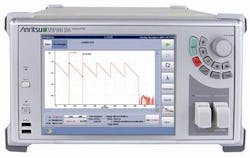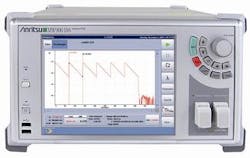Anritsu's Coherent OTDR targets submarine optical networks
MARCH 4, 2008 By Meghan Fuller Hanna -- At this year's OFC/NFOEC Conference, held last week in San Diego, CA, Anritsu Instruments Co. (search for Anritsu) introduced a coherent OTDR (C-OTDR) specifically designed to characterize submarine optical networks. The company claims its MW90010A C-OTDR can measure optical submarine cables as long as 12,000 km with 100 times the accuracy of previous instruments.
A conventional OTDR cannot accurately characterize a submarine cable because such cables rely on repeaters or Erbium-doped fiber amplifiers (search for EDFAs) for a periodic boost or regeneration of the signal. Because the EDFA is a one-way device, a conventional OTDR cannot measure beyond the first EDFA; no light reflected beyond that point is returned to the OTDR's test point.
A C-OTDR, therefore, must feature a separate transmit and receive port for connection to the network under test, explains Joe Arnello, manager of product marketing at Anritsu. "The C-OTDR launches light pulses into the outbound fiber and records the backscatter and reflections that are returned on the inbound fiber," he says. "The resulting trace looks like a series of conventional OTDR traces concatenated end to end."
The EDFAs create additional challenges as well. EDFAs accurately amplify a steady level of incoming light, but the pulses generated by a conventional OTDR are not transferred cleanly, Anello explains. Instead, the amplifier distorts the signal on the output. To mitigate this distortion, the C-OTDR's transmitter produces a second or "dummy" optical output that is present whenever the OTDR pulse is off. "The result is that the C-OTDR injects a nearly constant light level into the outbound fiber, which keeps the EDFAs operating properly and producing a clean output," he says.
Utilizing the advantages of the coherent detection scheme, the MW90010A can detect faults with 10-meter resolution and collect 1.2 million data points for accurate analysis on ultra-long optical submarine cables up to 12,000 km, say Anritsu representatives. Its wide dynamic range of less than 17 dB enables the MW90010A to measure submarine cables with optical repeaters spaced at intervals of 80 km or more.
Moreover, adds Anello, "because it is not always possible to remove traffic from the network prior to testing and because conventional OTDR out-of-band wavelengths like 1625 nm are not passed by the EDFAs," Anritsu's C-OTDR features a built-in tunable light source that can be tuned with ±0.2 nm accuracy in the range of 1535.03 nm ~ 1565.08 nm to support DWDM submarine cable systems.
The new device is much smaller than previously available C-OTDRs--about the size of your average desktop PC case, Anello reports--and, at less than 17 kg, it is lightweight and portable. Additionally, the device features one-button operation, which is a trend seen throughout the OTDR market, from access to long-haul/submarine segments. In addition to fault detection, the C-OTDR also captures important waveform data--including cable loss, bending loss, and fiber length--that support detailed cable evaluation.
Though C-OTDR technology has been around for a number of years, Anello says Anritsu's MW90010A is the only C-OTDR currently on the market.
Visit Anritsu Instruments Company

